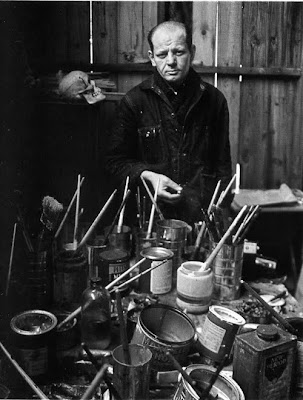
1. When the German-born American painter Hans Hofmann invited Pollock to study with him and work more from nature, Pollock replied: “I am nature.”
2. For a time, Pollock sprayed paint onto the canvas through a syringe.
3. In the summer of 1938, Pollock had a nervous breakdown, which left him in a psychiatric care unit for a few months.
4. While living in Los Angeles, Pollock’s eldest brother, Charles, kept the rest of the family informed with what was happening in the art world by regularly sending home issues of The Dial and American Mercury.
5. Some people would buy Pollock drinks at the bar just to see what kind of bizarre antics he would get up to when drunk.
6. In January 1951, Art News published a list of the best exhibitions of 1950. The top three shows belonged to Pollock.
7. After Pollock and his wife, Lee Krasner, moved into their Long Island home, Pollock spent the entire winter fixing up the house without painting a single thing.
8. While still a young man, Pollock once traveled by freight train around Oklahoma and northern Texas, where he met vagrants, prostitutes, and did a few short stints in jail.
9. Pollock once had a job cleaning statues for the Emergency Relief Bureau. He also briefly worked as a janitor with his brother, Sanford, at a children’s school where their eldest brother, Charles, taught.
10. When a teenager, Pollock once wrote, “People have always frightened and bored me consequently I have been within my own shell.”

11. Before becoming a painter, Pollock was primarily interested in sculpture.
12. Betty Parsons, a former dealer of Pollock’s, said Pollock was born with “too big an engine inside.”
13. Through a friend, Pollock was introduced to the spiritual beliefs of the Theosophical Society and the teachings of Jiddu Krishnamurti. Pollock attended several camp meetings in Ojai, California.
14. For a time, Pollock underwent psychiatric treatment for his alcoholism, including sessions with Jungian psychoanalysts Joseph L. Henderson and later Dr. Violet Staub de Laszlo. Both used Pollock’s drawings as a therapeutic device.
15. One of Pollock’s favorite authors was Herman Melville. Pollock named his dog “Captain Ahab,” after one of Melville’s most famous characters.
16. Pollock once wrote in a letter to his father, “I’ll never be satisfied until I’m able to mould a mountain of stone with the aid of a jack hammer to fit my will.”
17. According to his wife, Lee Krasner, Pollock began titling his later works with numbers because “numbers are neutral. They force people to look at the picture for what it is — pure painting.”
18. In 1930, Pollock decided to drop his birth name, “Paul.”
19. During the summer of 1950, photographer Hans Namuth took hundreds of pictures and shot some film footage of Pollock at work. After the session, Pollock had his first drink in two years, and began drinking heavily again until his death.
20. In 1941, Pollock was declared unfit for military service.

21. In the late 1930s, Pollock filled several notebooks with sketches of Picasso’s Guernica.
22. In 1936, Pollock met his future wife, Lee Krasner, at a party. The two didn’t meet again until 1941.
23. In his Los Angeles high school, Pollock was considered a troublemaker. He wore long hair, unconventional clothing, and was expelled several times for clashing with authorities. In a letter to his older brother, Charles, Pollock wrote, “this so called happy part of one’s life youth to me is a bit of damnable hell.”
24. Pollock once said, “There was a reviewer a while back who wrote that my pictures didn’t have any beginning or any end. He didn’t mean it as a compliment, but it was.”
25. For a time, Pollock took on the pseudonym, “Hugo.”
26. When Pollock’s father, LeRoy, died on March 6, 1933, Pollock did not have enough money to return home for the funeral.
27. While living on Long Island, Pollock converted his barn into a studio. Since the barn had no electric lights, Pollock worked strictly by sunlight.
28. Although Pollock’s parents were both Presbyterians, Pollock and his four older brothers received no religious education as children.
29. During the 1930s, Pollock occasionally stole food and gasoline because of his dire financial situation.
30. When Pollock was a boy, he enjoyed exploring old Native American sites around his home near Phoenix.

31. In high school, Pollock shared studio space with some of his friends in a chicken coop, which was decorated with postcards of classical art.
32. Pollock habitually worked late and slept through the morning.
33. In a letter to his father, Pollock once wrote, “A good seventy years more and I think I’ll make a good artist —being an artist is life itself — living it I mean.”
34. The first of Pollock’s paintings to be acquired by a museum was The She-Wolf, bought by MoMA for $650 on May 2, 1944. Pollock said of the painting: “She-Wolf came into existence because I had to paint it. Any attempt on my part to say something about it, to attempt explanation on the inexplicable, could only destroy it.”
35. In 1955, Pollock obtained a passport that he never ended up using.
36. Pollock’s problems with alcohol began one summer when he was conducting topographic surveys of the Grand Canyon. He was 15 years old.
37. For one summer, Pollock worked as a lumberjack in Big Pines, California.
38. Near the end of his life, Pollock told Dr. Elizabeth Wright Hubbard, his homeopathic physician, that he wasn’t painting anymore because he wasn’t sure he had anything to say.
39. Pollock once said that the only American painter who interested him was Albert Pinkham Ryder.
40. Friends and family described the young Pollock as childish, troubled, insecure, restive, and driven.

41. On July 21, 1937, Pollock was arrested for drunkenness and breach of the peace.
42. Pollock would often wander around New York City at night. He marveled at the contrast between the dark shadows and the skyscraper’s bright lights.
43. One of Pollock’s most influential teachers, Thomas Hart Benton, believed the most important lesson a burgeoning artist could learn from the Old Masters is the process of how they painted.
44. In 1947, Pollock applied for a fellowship from the Guggenheim Foundation, but was rejected.
45. In 1919, when Pollock was 7, his family bought a hotel in Janesville, California.
46. Pollock never graduated from high school.
47. Lee Krasner, Pollock’s future wife, first heard of Pollock when she was invited to participate in a group exhibition that included his work, called French and American Painting.
48. Pollock enjoyed telling spooky stories about the West involving wild stallions, white wolves, lost gold mines, and mysterious unattended campfires.
49. Pollock’s father, Le Roy McCoy, acquired the surname “Pollock” when his neighbors, the Pollocks, adopted him after his own parents had passed away within a year of each other.
50. When Pollock used to drink at New York City’s Cedar Tavern, young artists would frequently try to touch him for good luck.
Labels: Art, Jackson Pollock












